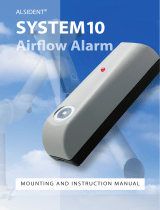
EcoBreeze System Operation and Maintenance2
General Information
Overview
The EcoBreeze™ is a modular indirect evaporative and air-to-air heat exchanger cooling
solution. The EcoBreeze has the ability to switch automatically between air-to-air and indirect
evaporative heat exchange to consistently provide cooling to data centers in the most efficient
way. The design of the EcoBreeze is able to reduce energy consumption by leveraging
temperature differences between outside ambient air compared to IT return air to provide
economized cooling to the data center. The EcoBreeze meets ASHRAE 90.1/TC 9.9
requirements for efficiency and economization with multiple Frame sizes with varying voltages
and phases to address the cooling needs of any data center.
The EcoBreeze not only provides multiple types of air economization, its modular design allows
the unit to adapt to the future cooling needs of the data center. These features, coupled with the
fact that the unit uses outside air and is able to automatically switch to the most efficient of
cooling modes, set the EcoBreeze apart from other cooling solutions.
The EcoBreeze is available in individual 50kW Modules that can be grouped up to four
Modules (200kW) or eight Modules (400kW) of sensible cooling. This modular, scalable
approach enables purchasing only what is needed to meet current cooling requirements while
giving the ability to increase cooling capacity at any time as the data center grows. This system
of multiple Modules provides redundancy for critical components such fans, pumps, controllers,
and sensors to minimize single-point failure from Module-to-Frame level and ensures
availability of the system even through maintenance and service intervals. Power, water, air
flow distribution and communication connections are centralized to the Frame simplifying
installation requirements. Additionally, as the unit is located outside the perimeter of the data
center, the EcoBreeze takes up zero whitespace in the data center, enabling IT managers to
utilize the space to increase capacity without needing to use any of that space for additional
cooling units.
Frame
The Frame is the housing and common support infrastructure for up to either four or eight
Modules. The Frame provides the components and subsystems needed to support the water
supply to and from the Modules for indirect evaporative cooling. Basic features of the Frame
water system include redundant pumps and flow monitor, redundant makeup water supply,
basin drain and blow-down, conductivity monitoring and control along with chemical free water
treatment.
The Frame provides the interface between the main power connection and power distribution
for each Module. This Module power distribution is protected with overload protection and can
be isolated at the Module level for servicing or removing Modules from the Frame.
The Frame and its interface between each Module facilitates air distribution between the
building ducts used for return and supply air.
The Frame is also where the dual master controllers are located. Dual master controllers
create redundancy for the system. Both controllers are identical and monitor all Modules and
external user interfaces the same way. The difference is that only the acting master controller
sends execution commands to Modules based on the information collected.




















